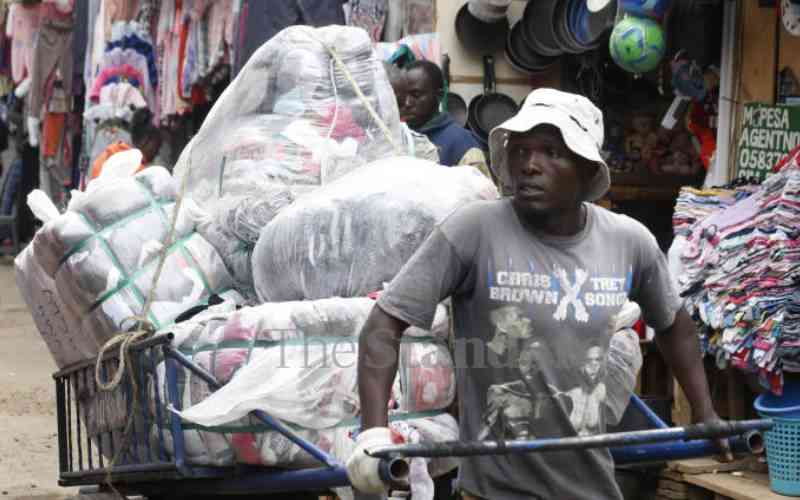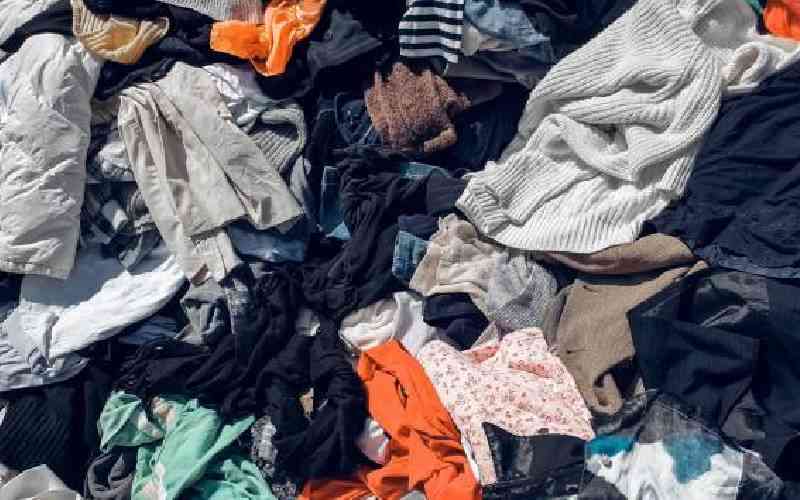
The issue of second-hand clothes excites an ever-unending debate, owing to its centrality in providing a livelihood to over two million Kenyans the sector employs.
Little wonder then that anything an incoming government intends to do around mitumba touches not only on the freedom to dress as one wishes and the pocket allows, but also affects livelihoods, considering our economy is largely an informal one.
But the mitumba debate rarely touches on the negative impact second-hand clothes have on the environment through mass dumping. The textile industry also contributes to increased carbon emissions, affecting climate change, besides drying up water sources and polluting rivers and streams.
According to a report by the Mitumba Institute and Research Centre (MIRC), Kenya is one of the largest importers of second-hand clothing in sub-Saharan Africa.
Bales of mitumba garments are ferried by trucks daily from Nairobi, Mombasa and Uganda to places like Kibuye Market in Kisumu County, which hosts more than 3,000 traders, a majority of them mitumba dealers.
Thriving business
The market has hundreds of shirts and dresses hanging from rails, trousers folded on wooden tables and thousands of other clothing items jumbled on cotton sheets on the ground.
Prices range between Sh100 for a short and Sh200 for trousers.
“When bales are offloaded, we sort them carefully into categories and that is what determines the price,” says John Omollo, a 10-year veteran of the business.
Linet Akinyi, also a trader, says other mitumba garments include thousands of underwear, T-shirts and socks piled onto carts and tables, some spilling onto the ground.
“It’s a thriving business where everyone makes reasonable profits,” says Akinyi.
Omollo and Akinyi are among thousands of small-scale traders in mitumba, a business which has taken root in Kenya.
The report by MIRC titled, ‘The global production networks of the second-hand clothing industry’, reveals that in the last six years, Kenya imported mitumba clothes with a nominal value of Sh18 billion, up from 10 billion, an 80 per cent increase.

It is also a huge source of employment: about two million Kenyans work in the mitumba market, making it a critical contributor of employment besides being a source of government revenue. This means it’s a critical sector for Kenya’s economy, and the negative impact when Covid-19 pandemic came calling was huge.
Something else; second-hand clothing and formal textiles are two distinct industries, and the players are hardly competitors.
Environmentalists have, however, raised concerns about the impact of second-hand clothes on the environment, considering that the fashion and textile industry is the second-largest polluter in the world, after the oil industry.
Major polluter
The United Nations Environment Programme (UNEP), in a report, says the environmental damage created by textile manufacturing is increasing as the industry expands.
According to the report, fashion production makes up 10 per cent of humanity’s carbon emissions, dries up water sources, and pollutes rivers and streams. What is more, 85 per cent of all textile are dumped each year.
Dr Isaac Ndede, an environmental health expert at Moi University, explains that the global fashion industry is a major polluter as it generates greenhouse gases during production, manufacturing and transportation of millions of garments bought annually.
Dr Ndede says the carbon footprint of a garment largely depends on the material. While synthetic fibres like polyester have less impact on water and land than grown materials like cotton, they emit more greenhouse gases per kilogramme.
Ndede said a majority of clothing used in first-world countries are not recycled, harming the environment, as the amount recycled cannot be absorbed by countries like Kenya, which import mitumba.

Prof Raphael Kapiyo, an environmental scientist at Maseno University, says mitumba can damage the environment “when people throw away clothes, thus adding to poorly managed solid waste”, as most mitumba clothes are left to accumulate, piling into landfills.
Prof Kapiyo says Kenya is experiencing more textile wastes from mitumba, yet less than 15 per cent of the clothes are recycled after wearing out while the rest go directly to the landfill sites or are incinerated.
Scientific studies show that when textile products hit landfill sites, they take up to 200 years to decompose.
But recycling of clothes through the mitumba sector, argues Prof Kapiyo, can benefit the environment and achieve improved outcomes in Kenya, if there is a policy to support regulation of supply chains through the creation of local sorting houses.
Evans Nyabuto, the corporate communications manager at National Environment Management Authority (NEMA), acknowledges the environmental policies in place to manage wastes, including those generated from mitumba.
“Mechanisms are in place to ensure that mitumba wastes are converted into organic wastes that are biodegradable,” said Nyabuto.
 The Standard Group Plc is a multi-media organization with investments in media platforms spanning newspaper print
operations, television, radio broadcasting, digital and online services. The Standard Group is recognized as a
leading multi-media house in Kenya with a key influence in matters of national and international interest.
The Standard Group Plc is a multi-media organization with investments in media platforms spanning newspaper print
operations, television, radio broadcasting, digital and online services. The Standard Group is recognized as a
leading multi-media house in Kenya with a key influence in matters of national and international interest.











